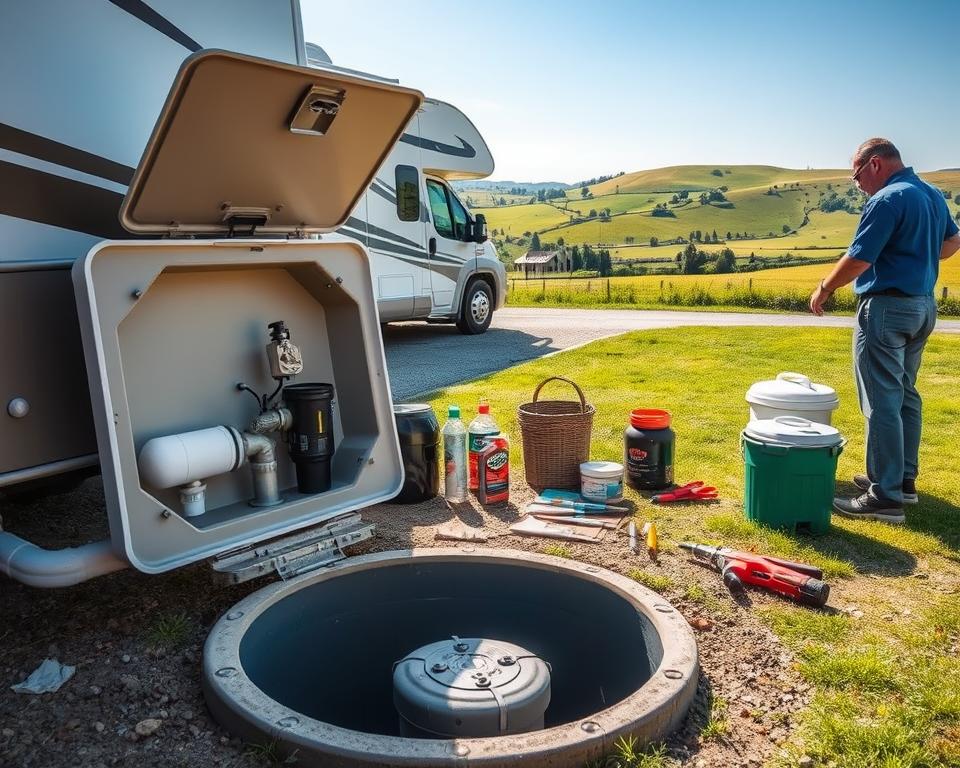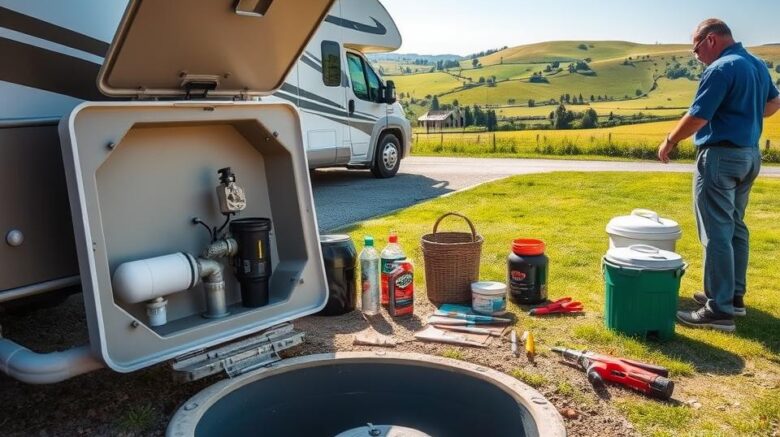RV Water Tank & Pump: – Definitive Manual
Eager to know the ingredient to easy roaming?? It’s all about your RV fresh-water Tank and Pump. If you’re heading to the national-park circuit or just a weekend retreat, understanding your RV’s water system is paramount. In this guide we break down the essentials: the components, upkeep, and strategies for glitch-free travel. Knowing each component, from the pipework to reservoir filling, secures water is always at your disposal during your outings – RV septic service near me.
Key Insights
- Knowing the RV water system enhances your travel enjoyment.
- The RV fresh-water Tank & Pump are indispensable for a steady water supply.
- Consistent servicing prolongs the lifespan of your RV plumbing.
- Knowing the right way to top up your Tank properly can forestall future issues.
- Fixing your water Pump can save you from unexpected problems.
Understanding RV Water Systems
RV water systems consist of two primary parts: the potable-water setup and the wastewater mechanism. The clean-water circuit includes several key elements like the water Tank, pressure Pump, and faucets, mirroring domestic plumbing while catering to the mobile needs of living on the move.
Ensuring potable water is paramount for the system’s reliability. It guarantees the health of all passengers. It’s important to keep the RV plumbing in excellent order through routine maintenance – including proper drainage to avoid leaks and other hiccups. Frequent inspections let RV enthusiasts sidestep water-related mishaps during their journeys.

Why You Need the RV Fresh-Water Tank
The RV fresh-water reservoir is indispensable for a seamless journey. It stores the fresh water needed for drinking, cooking, and cleaning. The volume of this Tank varies with each RV model, affecting how much water can be stored – and this directly influences how long you can stay off-grid before requiring a refill.
Maintaining the RV storage Tank clean is essential. Regular cleaning keeps at bay dangerous contaminants, ensuring water remains safe for use. Neglecting maintenance can promote bacteria or algae growth, rendering the water hazardous.
Recognising the RV Tank’s role streamlines water management during trips. Proper upkeep and regular refills provide a stress-free experience. It’s crucial to have ample water for all travel needs, ensuring a trouble-free RV adventure.
How to Fill Your RV Fresh-Water Tank
Filling your RV fresh-water reservoir requires attentive action to ensure it’s done correctly. There are two primary methods: gravity filling and pressure filling. Mastering these methods significantly improves your RV water routine.
Gravity filling is simple. You just need a food-grade water hose. Attach this hose to a water source, then to the fill opening, and let gravity handle the fill. Always watch the water level to avoid spills.
Using city pressure involves a city water connection, which is faster delivery. You should use a pressure regulator to manage water flow. Attach the hose from the municipal source to your RV. This approach provides quick and steady supply to your reservoir.
Either approach you select, remember these key safety tips: Always monitor the Tank when filling to prevent overflow, and use safe water to ward off health issues. Mastering these filling and safety techniques will turn your RV trips even more enjoyable.
RV Water Tank and Pump: Key Components Explored
The RV water Tank and Pump are vital to any RV’s plumbing system, delivering a consistent and smooth water supply for all your needs. The RV water Pump’s main job is to push water from the Tank, so clean water is always available. That’s critical for cooking, cleaning, and showering.
RV plumbing features different Pump types, each with unique benefits. Diaphragm-style Pumps are prized for their consistent water pressure, while centrifugal models are loved for ease and energy thrift. It’s important to weigh flow rate, noise, and installation ease when selecting your Pump.
To sum up, the RV Tank-Pump pair are indispensable to your water system’s functioning. A dependable Pump delivers strong pressure and smooth flow, improving your overall travel experience.
Picking the Perfect RV Water Pump
Choosing the correct RV water Pump is essential for your water system’s peak performance. When evaluating a Pump, considering various points is important for a great camping experience. Ensuring it matches your RV’s water system is paramount.
Keep these crucial aspects in mind:
- Flow Rate: Choose a Pump with a flow rate that suits your usage requirements. A higher flow means faster Tank refills.
- Pressure Ratings: Your RV’s multiple fixtures determine the needed pressure levels. Go with a Pump whose specs match those figures for smooth operation.
- Noise Levels: Noise can be an issue with some Pumps. For peace and quiet, contrast models for their noise output.
Brands like Shurflo and VEVOR are among the top picks for many RVers, providing distinct advantages. A careful assessment of these brands will help your selection process.
Understanding these factors is not only crucial for the proper purchase but also prepares DIY enthusiasts with essential know-how for upkeep and replacements.
Hooking Up to City Water for Your RV
Connecting your RV to city water allows for an continuous supply of fresh water, moving you beyond just using your Tank. This guarantees a more comfortable camping experience. Be sure to follow safe steps for a successful hookup.
First, find the city water connection port on your RV. It’s usually marked by a white or black connector, sometimes tagged for ease. Grab a potable water hose made for RVs; this type of hose keeps your water safe from contaminants.
It’s critical to install a pressure regulator before making the connection. This device safeguards your plumbing by controlling the water pressure. With the regulator in place, link the hose from it to the water source.
Once connected, monitor the water pressure. Aim for a steady, gentle flow to avoid hose damage. Inspect your hoses regularly for any wear or leaks and promptly replace parts as needed.
Sticking to these steps for city hookup boosts your camping convenience and helps in maintaining your RV’s condition.
Looking After Your RV Water Tank
Making sure your RV’s fresh-water reservoir is properly maintained is vital for safe, clean water while on the road. A well-maintained Tank avoids bacterial growth and contamination. For starters, regularly sanitise the Tank: mix water with a bit of bleach for an effective residue-free clean.
It’s crucial to watch for leaks and monitor Tank pressure. Regular checks can detect problems early, avoiding expensive fixes. A solid schedule keeps the water system in top shape.
To streamline maintenance, create a checklist:
- Check water levels and quality frequently.
- Sanitise the Tank every six months with a bleach solution.
- Inspect for cracks in the reservoir.
- Monitor Tank pressure and Pump function.
- Flush the Tank to eliminate any sediment buildup.
RV Water Pump Diagnostics
RV water Pump issues can be annoying, upending travel plans without warning. Facing strange noises, experiencing low pressure, or suffering complete Pump failure are typical problems. Understanding how to troubleshoot these issues can significantly enhance your trips.
If you hear odd sounds from your Pump may signal a problem. Start : check for loose connections and secure them. When there’s low water pressure, inspect hoses and fittings for leaks. Even a small leak can dramatically affect flow, early troubleshooting is essential.
If your Pump stops altogether, verify electrical connections. Start with examining the Pump’s fuse. Should the fuse is fine, look further for wear or damage.
A systematic routine isolates and fixes water system issues. Regular maintenance and inspection secure easier journeys.
| Issue | Possible Cause | Suggested Solution |
|---|---|---|
| Strange Noises | Loose connections | Tighten fittings |
| Low Pressure | Leaky hoses/fittings | Find & seal leaks |
| Pump Failure | Electrical fault | Check fuse/wiring |
| No Water Flow | Blocked lines | Flush obstructions |
Best Practices for Effective RV Water Use
Boondocking in off-grid areas usually means limited water access. Economical use in your RV is key. By adopting smart conservation tactics, you not only manage resources well but also boost camping satisfaction.
To make the most of water while travelling, consider these tips:
- Take quick showers – aim for under five minutes.
- Install water-saving fixtures like low-flow showerheads and faucets.
- Reuse grey water: dishwater can flush toilets or water plants.
- Monitor reservoir levels regularly to avoid overflow.
- Plan water stops in advance: know filling stations along your route.
Conclusion
Mastering the intricacies of your RV water systems is crucial to a fulfilling travel adventure. The water Tank & Pump remain at the core of this, needing consistent upkeep. By maintaining these systems, you ensure a dependable supply and sidestep potential snags.
Diligent troubleshooting and checks fetter stress and spare time. Being proactive about upkeep is essential, particularly when you’re far from help. Proper care enables you to maximise water use, raising comfort for everyone.
When you head out, leverage this guide to tame your RV’s water systems. Smart decisions about plumbing and equipment equip you to enjoy the freedom of the road. Here’s to happy and smooth travels ahead!
